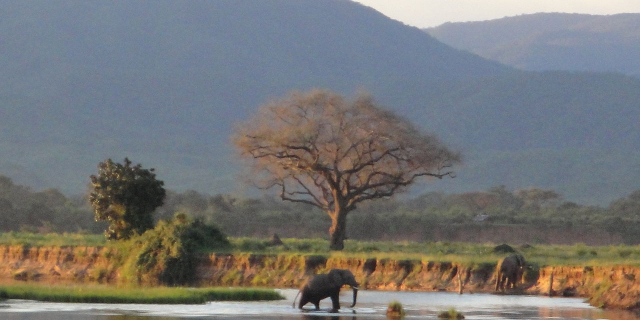Tanzania
Context of Tanzania
Tanzania (; Swahili: [tanzaˈni.a]), officially the United Republic of Tanzania (Swahili: Jamhuri ya Muungano wa Tanzania), is a country in East Africa within the African Great Lakes region. It borders Uganda to the north; Kenya to the northeast; the Indian Ocean to the east; Mozambique and Malawi to the south; Zambia to the southwest; and Rwanda, Burundi, and the Democratic Republic of the Congo to the west. Mount Kilimanjaro, Africa's highest mountain, is in northeastern Tanzania. According to the 2022 national census, Tanzania has a population of nearly 62 million, making it the fifth largest in Africa.
Many important hominid fossils have been found in Tanzania, such as 6-million-year-old Pliocene hominid foss...Read more
Tanzania (; Swahili: [tanzaˈni.a]), officially the United Republic of Tanzania (Swahili: Jamhuri ya Muungano wa Tanzania), is a country in East Africa within the African Great Lakes region. It borders Uganda to the north; Kenya to the northeast; the Indian Ocean to the east; Mozambique and Malawi to the south; Zambia to the southwest; and Rwanda, Burundi, and the Democratic Republic of the Congo to the west. Mount Kilimanjaro, Africa's highest mountain, is in northeastern Tanzania. According to the 2022 national census, Tanzania has a population of nearly 62 million, making it the fifth largest in Africa.
Many important hominid fossils have been found in Tanzania, such as 6-million-year-old Pliocene hominid fossils. The genus Australopithecus ranged across Africa between 4 and 2 million years ago, and the oldest remains of the genus Homo are found near Lake Olduvai. Following the rise of Homo erectus 1.8 million years ago, humanity spread all over the Old World, and later in the New World and Australia under the species Homo sapiens. H. sapiens also overtook Africa and absorbed the older species of humanity. Later in the Stone and Bronze Age, prehistoric migrations into Tanzania included Southern Cushitic speakers who moved south from present-day Ethiopia; Eastern Cushitic people who moved into Tanzania from north of Lake Turkana about 2,000 and 4,000 years ago; and the Southern Nilotes, including the Datoog, who originated from the present-day South Sudan–Ethiopia border region between 2,900 and 2,400 years ago.: page 18 These movements took place at about the same time as the settlement of the Mashariki Bantu from West Africa in the Lake Victoria and Lake Tanganyika areas. They subsequently migrated across the rest of Tanzania between 2,300 and 1,700 years ago.
In the late 19th century the mainland came under German rule as German East Africa, and this was followed by British rule after World War I when it was governed as Tanganyika, with the Zanzibar Archipelago remaining a separate colonial jurisdiction. Following their respective independence in 1964 and 1966, the two entities merged in 1964 to form the United Republic of Tanzania. Tanganyika joined the British Commonwealth and Tanzania remains a member of the Commonwealth as a unified republic. Today the country is a presidential constitutional republic with the federal capital located in Dodoma; the former capital, Dar es Salaam, retains most government offices and is the country's largest city, principal port, and leading commercial centre. Tanzania is a de facto one-party state with the democratic socialist Chama Cha Mapinduzi party in power. The country has not experienced major internal strife since independence and is seen as one of the safest and most politically stable on the continent.
Tanzania's population is composed of about 120 ethnic, linguistic, and religious groups. Christianity is the largest religion in Tanzania, but there are also substantial Muslim and animist minorities. Over 100 different languages are spoken in Tanzania, making it the most linguistically diverse country in East Africa; the country does not have a de jure official language, although the national language is Swahili which is used in parliamentary debate, in the lower courts, and as a medium of instruction in primary school, spoken by up to 90% as a second language. English is used in foreign trade, in diplomacy, in higher courts, and as a medium of instruction in secondary and higher education, while Arabic is spoken in Zanzibar.
Tanzania is mountainous and densely forested in the north-east, where Mount Kilimanjaro is located. Three of Africa's Great Lakes are partly within Tanzania. To the north and west lie Lake Victoria, Africa's largest lake, and Lake Tanganyika, the continent's deepest lake, known for its unique species of fish. To the south lies Lake Malawi. The eastern shore is hot and humid, with the Zanzibar Archipelago just offshore. The Menai Bay Conservation Area is Zanzibar's largest marine protected area. The Kalambo Falls, located on the Kalambo River at the Zambian border, is the second-highest uninterrupted waterfall in Africa. Tanzania is one of the most visited tourist destinations for safaris.
More about Tanzania
- Currency Tanzanian shilling
- Calling code +255
- Internet domain .tz
- Mains voltage 230V/50Hz
- Democracy index 5.1
- Population 61741120
- Area 947303
- Driving side left
- Ancient
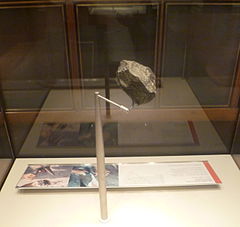 A 1.8-million-year-old stone chopping tool discovered at Olduvai Gorge and on display at the British Museum
A 1.8-million-year-old stone chopping tool discovered at Olduvai Gorge and on display at the British MuseumTanzania is one of the oldest continuously inhabited areas on Earth. Traces of fossil remains of humans and hominids date back to the Quaternary era. The Olduvai Gorge, in the Ngorongoro Conservation Area, a UNESCO World Heritage Site, features a collection with remnants of tools that document the development and use of transitional technology.
The indigenous populations of eastern Africa are thought to be the linguistically isolated Hadza and Sandawe hunter-gatherers of Tanzania.[1]: page 17
...Read moreRead lessAncient A 1.8-million-year-old stone chopping tool discovered at Olduvai Gorge and on display at the British Museum
A 1.8-million-year-old stone chopping tool discovered at Olduvai Gorge and on display at the British MuseumTanzania is one of the oldest continuously inhabited areas on Earth. Traces of fossil remains of humans and hominids date back to the Quaternary era. The Olduvai Gorge, in the Ngorongoro Conservation Area, a UNESCO World Heritage Site, features a collection with remnants of tools that document the development and use of transitional technology.
The indigenous populations of eastern Africa are thought to be the linguistically isolated Hadza and Sandawe hunter-gatherers of Tanzania.[1]: page 17
The first wave of migration was by Southern Cushitic speakers who moved south from Ethiopia and Somalia into Tanzania. They are ancestral to the Iraqw, Gorowa, and Burunge.[1]: page 17 Based on linguistic evidence, there may also have been two movements into Tanzania of Eastern Cushitic people at about 4,000 and 2,000 years ago, originating from north of Lake Turkana.[1]: pages 17–18
Archaeological evidence supports the conclusion that Southern Nilotes, including the Datoog, moved south from the present-day South Sudan / Ethiopia border region into central northern Tanzania between 2,900 and 2,400 years ago.[1]: page 18
These movements took place at approximately the same time as the settlement of the iron-making Mashariki Bantu from West Africa in the Lake Victoria and Lake Tanganyika areas. They brought with them the west African planting tradition and the primary staple of yams. They subsequently migrated out of these regions across the rest of Tanzania between 2,300 and 1,700 years ago.[1][2]
Eastern Nilotic peoples, including the Maasai, represent a more recent migration from present-day South Sudan within the past 500 to 1,500 years.[1][3]
The people of Tanzania have been associated with the production of iron and steel. The Pare people were the main producers of sought-after iron for peoples who occupied the mountain regions of north-eastern Tanzania.[4] The Haya people on the western shores of Lake Victoria invented a type of high-heat blast furnace, which allowed them to forge carbon steel at temperatures exceeding 1,820 °C (3,310 °F) more than 1,500 years ago.[5]
Travellers and merchants from the Persian Gulf and India have visited the east African coast since early in the first millennium AD.[6] Islam was practised by some on the Swahili Coast as early as the eighth or ninth century AD.[7]
MedievalBantu-speakers built farming and trade villages along the Tanzanian coast from the outset of the first millennium. Archaeological finds at Fukuchani, on the north-west coast of Zanzibar, indicate a settled agricultural and fishing community from the 6th century CE at the latest. The considerable amount of daub found indicates timber buildings, and shell beads, bead grinders, and iron slag have been found at the site. There is evidence for limited engagement in long-distance trade: a small amount of imported pottery has been found, less than 1% of total pottery finds, mostly from the Gulf and dated to the 5th to 8th century. The similarity to contemporary sites such as Mkokotoni and Dar es Salaam indicate a unified group of communities that developed into the first centre of coastal maritime culture. The coastal towns appear to have been engaged in Indian Ocean and inland African trade at this early period. Trade rapidly increased in importance and quantity beginning in the mid-8th century and by the close of the 10th century Zanzibar was one of the central Swahili trading towns.[8]
Growth in Egyptian and Persian shipping from the Red Sea and the Persian Gulf revitalised Indian Ocean trade, particularly after the Fatimid Caliphate relocated to Fustat (Cairo). Swahili agriculturalists built increasingly dense settlements to tap into trade, these forming the earliest Swahili city-states. The Venda-Shona Kingdoms of Mapungubwe and Zimbabwe in South Africa and Zimbabwe, respectively, became a major producer of gold around this same period. Economic, social, and religious power was increasingly vested in Kilwa, Tanzania's major medieval city-state. Kilwa controlled a number of smaller ports stretching down to modern-day Mozambique. Sofala became the major gold emporium and Kilwa grew rich off the trade, lying at the southern end of the Indian Ocean Monsoons. Kilwa's major rivals lay to the north, in modern-day Kenya, namely Mombasa and Malindi. Kilwa remained the major power in East Africa until the arrival of the Portuguese at the end of the 15th century.[9]
Colonial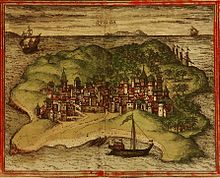 A 1572 depiction of the city of Kilwa, a UNESCO World Heritage Site
A 1572 depiction of the city of Kilwa, a UNESCO World Heritage SiteClaiming the coastal strip, Omani Sultan Said bin Sultan moved his capital to Zanzibar City in 1840. During this time, Zanzibar became the centre for the east African slave trade.[10] Between 65 and 90 per cent of the Arab-Swahili population of Zanzibar was enslaved.[11] One of the most infamous slave traders on the East African coast was Tippu Tip, who was the grandson of an enslaved African. The Nyamwezi slave traders operated under the leadership of Msiri and Mirambo.[12] According to Timothy Insoll, "Figures record the exporting of 718,000 slaves from the Swahili coast during the 19th century, and the retention of 769,000 on the coast."[13] In the 1890s, slavery was abolished.[14]
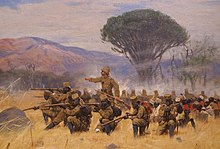 Battle during the Maji Maji Rebellion against German colonial rule in 1905
Battle during the Maji Maji Rebellion against German colonial rule in 1905In 1863, the Holy Ghost Mission established an early reception center and depot at Zanzibar. In 1877, responding to appeals of Henry Stanley following his trans-Africa expedition, and permission being given to Stanley by King Mutessa I of Buganda of Buganda, the Church Missionary Society sent missionaries Edward Baxter and Henry Cole to establish inland missions.[15][16][17] In 1885, Germany conquered the regions that are now Tanzania (minus Zanzibar) and incorporated them into German East Africa (GEA).[18] The Supreme Council of the 1919 Paris Peace Conference awarded all of GEA to Britain on 7 May 1919, over the strenuous objections of Belgium.[19]: 240 The British colonial secretary, Alfred Milner, and Belgium's minister plenipotentiary to the conference, Pierre Orts, then negotiated the Anglo-Belgian agreement of 30 May 1919[20]: 618–9 where Britain ceded the north-western GEA provinces of Ruanda and Urundi to Belgium.[19]: 246 The conference's Commission on Mandates ratified this agreement on 16 July 1919.[19]: 246–7 The Supreme Council accepted the agreement on 7 August 1919.[20]: 612–3 On 12 July 1919, the Commission on Mandates agreed that the small Kionga Triangle south of the Rovuma River would be given to Portuguese Mozambique,[19]: 243 with it eventually becoming part of independent Mozambique. The commission reasoned that Germany had virtually forced Portugal to cede the triangle in 1894.[19]: 243 The Treaty of Versailles was signed on 28 June 1919, although the treaty did not take effect until 10 January 1920. On that date, the GEA was transferred officially to Britain, Belgium, and Portugal. Also on that date, "Tanganyika" became the name of the British territory. In the mid-1920s, the British implemented a system of indirect rule in Tanzania.[21]
The Maji-Maji rebellion, between 1905 and 1907, was an uprising of several African tribes in German East Africa against the colonial authorities, in particular because of forced labor and deportation of certain tribes. It was the subject of a bloody repression, which combined with famine caused 300 000 deaths among the population.[22]
During World War II, about 100,000 people from Tanganyika joined the Allied forces[23] and were among the 375,000 Africans who fought with those forces.[24] Tanganyikans fought in units of the King's African Rifles during the East African Campaign in Somalia and Abyssinia against the Italians, in Madagascar against the Vichy French during the Madagascar Campaign, and in Burma against the Japanese during the Burma Campaign.[24] Tanganyika was an important source of food during this war, and its export income increased greatly compared to the pre-war years of the Great Depression[23] Wartime demand, however, caused increased commodity prices and massive inflation within the colony.[25]
In 1954, Julius Nyerere transformed an organisation into the politically oriented Tanganyika African National Union (TANU). TANU's main objective was to achieve national sovereignty for Tanganyika. A campaign to register new members was launched, and within a year, TANU had become the leading political organisation in the country. Nyerere became Minister of British-administered Tanganyika in 1960 and continued as prime minister when Tanganyika became independent in 1961.[26]
ModernBritish rule came to an end on 9 December 1961. Elizabeth II, who had acceded to the British throne in 1952, continued to reign through the first year of Tanganyika's independence, but now distinctly as Queen of Tanganyika, represented by the governor general.[27]: page 6 Tanganyika also joined the British Commonwealth in 1961.[28] On 9 December 1962, Tanganyika became a democratic republic under an executive president.[27]: page 6
After the Zanzibar Revolution overthrew the Arab dynasty in neighbouring Zanzibar, accompanied with the slaughter of thousands of Arab Zanzibaris,[29] which had become independent in 1963, the archipelago merged with mainland Tanganyika on 26 April 1964.[30] The new country was then named the United Republic of Tanganyika and Zanzibar.[31][32] On 29 October of the same year, the country was renamed the United Republic of Tanzania ("Tan" comes from Tanganyika and "Zan" from Zanzibar).[33] The union of the two hitherto separate regions was controversial among many Zanzibaris (even those sympathetic to the revolution) but was accepted by both the Nyerere government and the Revolutionary Government of Zanzibar owing to shared political values and goals.[34]
Following Tanganyika's independence and unification with Zanzibar leading to the state of Tanzania, President Nyerere emphasised a need to construct a national identity for the citizens of the new country. To achieve this, Nyerere provided what is regarded as one of the most successful cases of ethnic repression and identity transformation in Africa.[35] With more than 130 languages spoken within its territory, Tanzania is one of the most ethnically diverse countries in Africa. Despite this obstacle, ethnic divisions remained rare in Tanzania when compared to the rest of the continent, notably its immediate neighbour, Kenya. Furthermore, since its independence, Tanzania has displayed more political stability than most African countries, particularly due to Nyerere's ethnic repression methods.[36]
 The Arusha Declaration Monument
The Arusha Declaration MonumentIn 1967, Nyerere's first presidency took a turn to the left after the Arusha Declaration, which codified a commitment to socialism as well as Pan-Africanism. After the declaration, banks and many large industries were nationalised.
Tanzania was also aligned with China, which from 1970 to 1975 financed and helped build the 1,860-kilometre-long (1,160 mi) TAZARA Railway from Dar es Salaam to Zambia.[37] Nonetheless, from the late 1970s, Tanzania's economy took a turn for the worse, in the context of an international economic crisis affecting both developed and developing economies.
In 1978, the neighbouring Uganda, under the leadership of Idi Amin, invaded Tanzania. This disastrous invasion would culminate in Tanzania invading Uganda with the aid of Ugandan rebels and deposing Idi Amin as a result. However, the war severely damaged Tanzania's economy.
Through the 1980s, conservation oriented national parks such as Serengeti and Kilimanjaro, with Mount Kilimanjaro as the tallest freestanding summit on Earth, were included on the UNESCO World Heritage List.
From the mid-1980s, the regime financed itself by borrowing from the International Monetary Fund and underwent some reforms. Since then, Tanzania's gross domestic product per capita has grown and poverty has been reduced, according to a report by the World Bank.[38]
In 1992, the Constitution of Tanzania was amended to allow multiple political parties.[39] In Tanzania's first multi-party elections, held in 1995, the ruling Chama Cha Mapinduzi won 186 of the 232 elected seats in the National Assembly, and Benjamin Mkapa was elected as president.[40]
The presidents of Tanzania since Independence have been Julius Nyerere 1962–1985, Ali Hassan Mwinyi 1985–1995, Benjamin Mkapa 1995–2005 Jakaya Kikwete 2005–2015 John Magufuli 2015–2021 and Samia Hassan Suluhu since 2021.[41] After the long tenure of president Nyerere, the Constitution has a term limit: a president can serve a maximum of two terms. Each term is five years.[42] Every president has represented the ruling party Chama cha Mapinduzi (CCM).[43] President Magufuli won a landslide victory and re-election in October 2020. According to the opposition, the election was full of fraud and irregularities.[44]
On 17 March 2021, President John Magufuli died from heart complications while in office.[45] Magufuli's vice president, Samia Suluhu Hassan, became Tanzania's first female president.[46]
^ a b c d e f Tishkoff, S. A.; Reed, F. A.; Friedlaender, F. R.; Ehret, C.; Ranciaro, A.; Froment, A.; Hirbo, J. B.; Awomoyi, A. A.; Bodo, J. M.; Doumbo, O.; Ibrahim, M.; Juma, A. T.; Kotze, M. J.; Lema, G.; Moore, J. H.; Mortensen, H.; Nyambo, T. B.; Omar, S. A.; Powell, K.; Pretorius, G. S.; Smith, M. W.; Thera, M. A.; Wambebe, C.; Weber, J. L.; Williams, S. M. (2009). "The Genetic Structure and History of Africans and African Americans". Science. 324 (5930): 1035–44. Bibcode:2009Sci...324.1035T. doi:10.1126/science.1172257. PMC 2947357. PMID 19407144. ^ Cite error: The named reference auto was invoked but never defined (see the help page). ^ Martin, Phyllis; O'Meara, Patrick (1995). Africa. Indiana University Press. ISBN 978-0-253-20984-9. ^ Shoup, John A. (2011). Ethnic groups of Africa and the Middle East : an encyclopedia. Santa Barbara, CA: ABC-CLIO. p. 67. ISBN 978-1-59884-362-0. ^ Schmidt, P.; Avery, D.H. (1978). "Complex iron smelting and prehistoric culture in Tanzania". Science. 201 (4361): 1085–89. Bibcode:1978Sci...201.1085S. doi:10.1126/science.201.4361.1085. PMID 17830304. S2CID 37926350. ^ Shillington, Kevin (2013). Encyclopedia of African History 3-Volume Set. Routledge. p. 1510. ISBN 978-1-135-45670-2. ^ "The Story of Africa". BBC World Service. ^ Horton, Mark and Middleton, Tom. "The Swahili: The Social Landscape of a Mercantile Community." (Oxford: Blackwell, 2010), 46. ^ Campbell, Gwyn. "Africa and the Indian Ocean World from Early Times to Circa 1900." Cambridge University Press. 2019 ^ "Slavery". Encyclopædia Britannica. Archived from the original on 6 October 2014. ^ "Slave societies". Encyclopædia Britannica. 22 January 2014. Retrieved 19 February 2014. ^ "The Story of Africa |BBC World Service". BBC. ^ Rodriguez, Junius P. (1997). The Historical Encyclopedia of World Slavery. ABC-CLIO. ISBN 978-0-87436-885-7. ^ "On The Zanzibar Map: Spices, Slaves And A Bit Of History". 17 February 2015. ^ Middleton, Dorothy (6 May 2022). "Henry Morton Stanley". Encyclopedia Britannica. Retrieved 29 December 2022. ^ Johnson, Hildergard Binder (1967). "The Locations of Christian Missions in Africa". Geographical Review. Taylor and Francis Ltd. 57 (2): 168–202. doi:10.2307/213158. JSTOR 213158. Retrieved 29 December 2022. ^ "Europeans In East Africa - View entry". www.europeansineastafrica.co.uk. Retrieved 18 December 2022. ^ Fall, Makhete (2016). Early Political Discord in Kenya: European Settlers' Political Struggles in the East Africa Protectorate, 1902–1912 (Thesis). West Virginia University Libraries. doi:10.33915/etd.5569. ^ a b c d e William Roger Louis (2006). Ends of British Imperialism: The Scramble for Empire, Suez, and Decolonization. I.B. Tauris. ISBN 978-1-84511-347-6. Retrieved 19 September 2017. ^ a b "PAPERS RELATING TO THE FOREIGN RELATIONS OF THE UNITED STATES, THE PARIS PEACE CONFERENCE, 1919". United States Department of State. Retrieved 19 September 2017. ^ Liebenow, J. Gus (1956). "Responses to Planned Political Change in a Tanganyika Tribal Group". American Political Science Review. 50 (2): 447–448. doi:10.2307/1951678. ISSN 0003-0554. JSTOR 1951678. S2CID 144390538. ^ John Iliffe, "The Organization of the Maji Maji Rebellion" The Journal of African History, pp. 495–512 ^ a b Heale, Jay; Wong, Winnie (2010). Tanzania. Marshall Cavendish. ISBN 978-0-7614-3417-7. ^ a b "African participants in the Second World War". mgtrust.org. ^ "Tanzania: British rule between the Wars (1916–1945)". eisa.org.za. Archived 4 February 2015 at the Wayback Machine ^ Mulenga, Derek C. (November 2001). "Mwalimu Julius Nyerere: a critical review of his contributions to adult education and postcolonialism". International Journal of Lifelong Education. 20 (6): 446–470. doi:10.1080/02601370110088436. ISSN 0260-1370. S2CID 143740319. ^ a b Cite error: The named reference Abstract was invoked but never defined (see the help page). ^ Cite error: The named reference auto1 was invoked but never defined (see the help page). ^ "Unveiling Zanzibar's unhealed wounds". BBC News. 25 July 2009. ^ "Background history of The Union between Tanganyika and Zanzibar" (PDF). Vice President's Office, United Republic of Tanzania. Archived from the original (PDF) on 25 January 2013. Retrieved 25 April 2013. ^ "The United Republic of Tanganyika and Zanzibar is renamed United Republic of Tanzania". South African History Online. Retrieved 10 February 2019. ^ "United Republic of Tanzania : History". Commonwealth.org. Archived from the original on 23 February 2019. Retrieved 10 February 2019. ^ Cite error: The named reference factbook was invoked but never defined (see the help page). ^ "viajes a Tanzania". rutastanzania.viajes - ES (in European Spanish). ^ Pierre Englebert and Kevin C. Dunn, "Inside African Politics" 2013: 81 ^ Henry Bienen and John Waterbury, "World Development Vol 17", 1989: 100 ^ Monson, Jamie (2009). Africa's Freedom Railway: How a Chinese Development Project Changed Lives and Livelihoods in Tanzania. Indiana University Press. p. 199. ISBN 978-0-253-35271-2. ^ Muganda, Anna (2004). "Tanzania's Economic Reforms – and Lessons Learned" (PDF). Retrieved 19 February 2014. ^ "Tanzania 1992". Archived 18 October 2014 at the Wayback Machine. princeton.edu. ^ "Tanzania: 1995 National Assembly election results". Archived from the original on 18 March 2015. ^ "Presidents Of Tanzania Since Independence". WorldAtlas. 25 April 2017. Retrieved 2 June 2021. ^ "Mgoya: Why I want presidential term limit scrapped in Tanzania". The East African. 6 July 2020. Retrieved 2 June 2021. ^ "Magufuli is Transforming Tanzania's Ruling Party From a 'Benign Hegemon' Into a Malevolent One". Council on Foreign Relations. Retrieved 2 June 2021. ^ "Magufuli wins re-election in Tanzania; opposition cries foul". www.aljazeera.com. Retrieved 2 June 2021. ^ "John Magufuli: Tanzania's president dies aged 61". BBC News. 18 March 2021. Retrieved 18 March 2021. ^ "Samia Suluhu Hassan becomes President following death of John Magufuli". BBC News. 18 March 2021. Retrieved 18 March 2021.
- Stay safe Theft
As in many impoverished countries, caution should always be exercised, particularly in tourist areas, such as Arusha, Stone Town (Zanzibar), and Dar es Salaam. Violent crime against foreigners is not uncommon, particularly against those walking alone at night, which is not recommended. Pickpocketing and con artists are also common. Pickpockets work crowded markets, like Kariakoo, and bus stations. Don't be fooled by small children who are often forced into a life of crime by older kids or parents -- never carry anything of value in your pockets and don't let expensive camera equipment dangle from your neck. Don't leave bags unattended or even out of your sight when on the beach.
See specific area or city articles for details.
In general, avoid isolated areas, especially after dark. Travelling in large groups is safer. If there are many people or security guards around (e.g. city center areas) you should be relatively safe.
The safest way to travel is by taxi with a driver you know, especially when it's dark out (late night or early morning). Although it's uncommon, taxi drivers have been known to rob tourists. Get the number for a taxi you trust, from your hotel or a local.
Buses have infrequently been stopped by robbers on long-distance (often overnight) routes. If you have to travel a long distance by bus, it might be better to break it into multiple day-only trips, or to travel by plane or train.
In the event of an incident, the police may or may not make a strong effort to identify the culprits, but obtaining a police report is necessary if you plan on filing an insurance claim later, or if important documents are stolen. Make sure the police report indicates if your papers were stolen; otherwise you may have difficulty leaving the country. You should immediately contact your local embassy or consulate in the event that your passport is taken.
...Read moreStay safe TheftRead lessAs in many impoverished countries, caution should always be exercised, particularly in tourist areas, such as Arusha, Stone Town (Zanzibar), and Dar es Salaam. Violent crime against foreigners is not uncommon, particularly against those walking alone at night, which is not recommended. Pickpocketing and con artists are also common. Pickpockets work crowded markets, like Kariakoo, and bus stations. Don't be fooled by small children who are often forced into a life of crime by older kids or parents -- never carry anything of value in your pockets and don't let expensive camera equipment dangle from your neck. Don't leave bags unattended or even out of your sight when on the beach.
See specific area or city articles for details.
In general, avoid isolated areas, especially after dark. Travelling in large groups is safer. If there are many people or security guards around (e.g. city center areas) you should be relatively safe.
The safest way to travel is by taxi with a driver you know, especially when it's dark out (late night or early morning). Although it's uncommon, taxi drivers have been known to rob tourists. Get the number for a taxi you trust, from your hotel or a local.
Buses have infrequently been stopped by robbers on long-distance (often overnight) routes. If you have to travel a long distance by bus, it might be better to break it into multiple day-only trips, or to travel by plane or train.
In the event of an incident, the police may or may not make a strong effort to identify the culprits, but obtaining a police report is necessary if you plan on filing an insurance claim later, or if important documents are stolen. Make sure the police report indicates if your papers were stolen; otherwise you may have difficulty leaving the country. You should immediately contact your local embassy or consulate in the event that your passport is taken.
Walking Zanzibar sunset
Zanzibar sunsetThere are very few sidewalks in Tanzania, always pay careful attention to the traffic and be prepared to move out of the way, as vehicles do not make much effort to avoid pedestrians. In Tanzania, cars have priority.
The best way to avoid touts, sellers, dealers etc., when they inevitably come up to you and say "jambo" is to either say nothing, or to say "thank you" or "asante", and to keep moving. Some may be offended by 'no', and persistent touts will be encouraged by any kind of interaction at all.
CorruptionTanzania, like many developing countries, suffers from corruption. Police are poorly paid - many make less than US$40/month. You may be solicited for a bribe by an official willing to turn a blind eye to your infraction, fabricated or otherwise. Some travellers are very much averse to paying bribes to anyone, especially in a country with so many needy but honest citizens.
Fraudsters are known to impersonate police, sometimes in the guise of an "immigration official" who identifies a problem with your documents. They will flash official-looking papers at you. But there are many plainclothes officers as well. And if you are confronted with someone in uniform, they will almost certainly be an actual officer.
On-the-spot-fine is one term used for a bribe. Those words are meant to initiate a conversation about money. You may be told that the real fine is TSh 40,000 or more and that for TSh 20,000 or 30,000, paid immediately, you can be on your way and avoid a trip to the Police Station to pay a higher fine.
If you are certain you are in the right, and do not want to pay a bribe, some strategies are:
Involve other people. Fraudsters or corrupt officials are unlikely to pursue their schemes near an audience. You can ask bystanders for help on the pretext of not understanding the officer. Invoke higher powers. Insisting on going to the local police station is a good way to make an illegitimate issue go away. Suggesting a visit to your country's embassy (e.g. to have an official there help translate the conversation, due to one's poor knowledge of the local language and laws) is also effective. At this point, they usually have a look of horror on their face, since they don't want any real officials involved. Asking for bribes is illegal, and there is an office of corruption where they can be reported. Play dumb. Politely explain to the person that you don't understand the nature of the infraction, even if you do. Tanzanians are not direct, and prefer to imply what they want, instead of asking outright. Tell them you've only just arrived in the country, even if it's your 100th visit. If you know some Kiswahili, don't let on. It may only make things harder. Insist a receipt with an official stamp -- a request that is most likely to be met with confusion and concern. The idea is to show that you don’t know that this is actually a bribe and that you simply try to play by the rules. Hopefully, after 10 or 20 minutes of a circular, but always polite, conversation, they may send you on your merry way. A word of caution about this approach: corrupt officials have become wise to this and in one case a person requesting a receipt was told the cashier's office was closed and would not open until the next morning. The options were to pay the fine or spend the night in prison. It appears this was not a bluff on the part of the officer. The fine was paid and no receipt was issued. The game is constantly changing.Also:
Discussing money or negotiating the fine may encourage the perception that you understand the nature of the conversation (i.e. you are willing to pay a bribe). Directly accusing the officer of corruption is likely to be counter-productive; it is important that you allow the officer to save face. If you insist on going to the police station, you may be expected to give the officer a ride. If you are alone, and especially if the "officer" is plainclothes, this may not be a good idea. If you are approached by multiple people and are alone, under no circumstances get in their vehicle - insist on taking a taxi. And once you get to the station, just pay whatever fine is quoted and insist on a receipt. This may end up costing you more than the bribe, but at least this cop won't get any money out of you, and he/she may think twice before flagging down other foreigners. Also, demonstrate respect for their authority, never raise your voice, and never swear or insult them. Whether you are right or not does not matter at that point.Finally: incidents of excessive force involving tourists are rare, but that doesn’t mean it cannot happen. For instance, police have been known to be drunk on the job, which can seriously inhibit their ability to reason. As in any situation where someone is trying to get money out of you, by force or threat of force, it's better to be safe than sorry; it's only money.















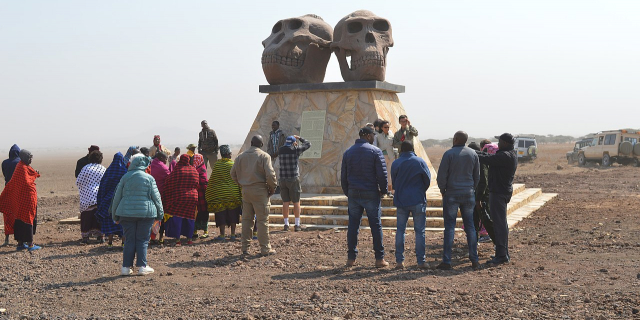

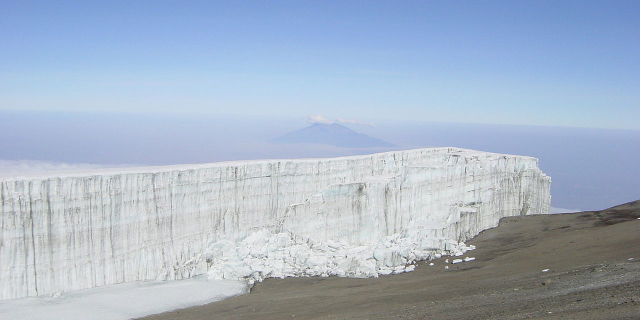




![Cliff Kemper[2] - CC BY-SA 2.0](/sites/default/files/styles/640x320/public/2022-03/Serengeti_gazelles.jpeg?h=ead717b0&itok=JsZMti_M)











